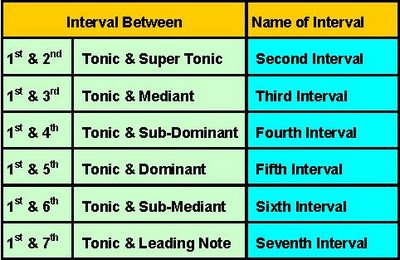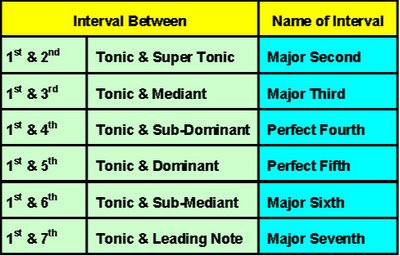(continued from Lesson-20.......)
We are trying to establish the relationship between the Tonic, the first note of a scale and the Other notes of the same scale.
The relationship is expressed in terms of the interval between two notes.
As we are clear that, the Major Scale is consisting of seven notes.
The relation ship is expressed through the interval, which is primarily named by the number of notes above/ below the first reference note.
Taking Tonic as the reference,

Its easy to learn interval…. Isn’t it ?
Just , 2nd, 3rd, 4th, 5th, 6th, & 7th ….. that’s all. Ok.. ….
As we generally know, the interval between 1st & 8th is called an Octave.
In case of anything above them viz. 9th, 10th etc are repetition of the same intervals like 2nd, 3rd and so on.
These are called Compound 2nd, Compound 3rd and so on.
Still, some small problem…..
This only give a general title of the relationship , but if you want to go further deep to feel the characteristic of the relationship, we need to add certain additional title to that.
For example, a 3rd only denotes the interval of a 3rd note from the reference note.
As we already know, for the third note, depending on the type of scale, we may be using a white key, or a black key above or below etc…
So, we have to specifically say which type of 3rd is this .
This is done by adding certain Prefix to the simple title of 2nd, 3rd etc
The various such prefixes which are normally getting added to an interval number are as follows :
- Minor,
- Major,
- Perfect,
- Augmented &
- Diminished
Basically, such classifications were formed on the traditional study of the Sound quality of these intervals and conclusions arrived at.
For the time being we will not get into those complications of reasons for the name and others.
What we will learn just now is the titles associated with our normal Major Scale which we are now concentrating upon.
In the case of a Major Scale, the name of these intervals (w.r.t. Tonic … don’t forget that….! ) are as follows ;
The 4th & 5th are called Perfect intervals.
The 2nd, 3rd, 6th, 7th, are called the Major Intervals
With this we can summarise the names of the intervals in a Major Scale as follows:
You just believe it ! And Memorise it !
Easy, because in Major scale everything is Major intervals except the 4th and 5th which are Perfect intervals !
Any Major Scale which follows the rule of (Whole + Whole + Semi) + Whole + (Whole + Whole + Semi ) will have these intervals w.r.t. the Tonic.
Just for your idea :
• Any interval a semitone lesser than Major interval is called a Minor Interval.
• Any interval a semitone lesser than Minor interval is called a Diminished Interval
• Any interval a semitone more than a Major interval is called a Augmented Interval
We will discuss them later.
Now we know some more jargons…and we are a little bit more wiser….!
Hereafter, if somebody talks about major, minor, augmented, diminished, perfect…etc etc… we need not turn our faces & ears away with some aversion, ……
Rather now, we will listen to them a little more confidently, attentively… !
Later on, while we learn our chords and related subject, these terms will be repeated a lot of time…
and by that time, we will be master of these terms…!

No comments:
Post a Comment